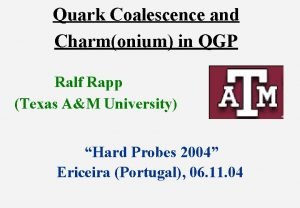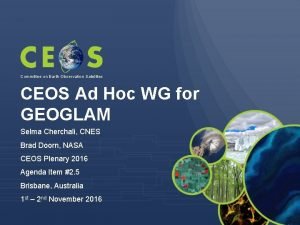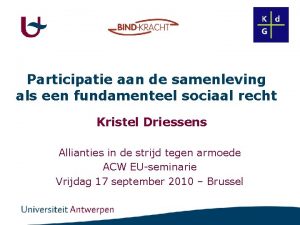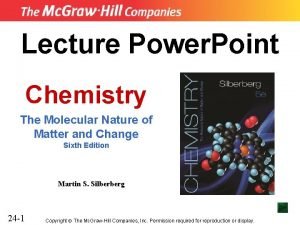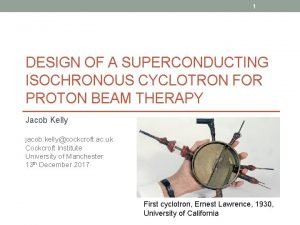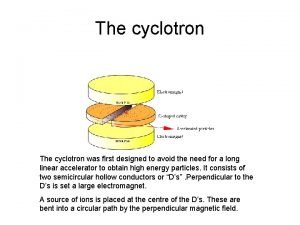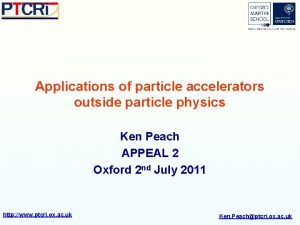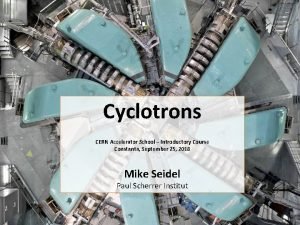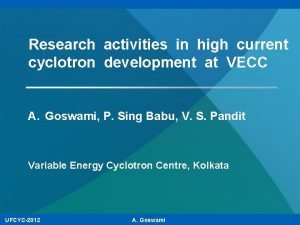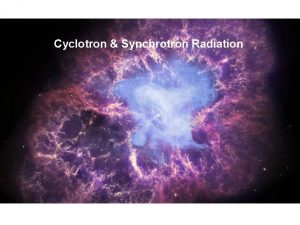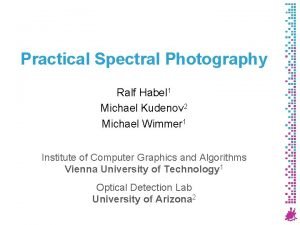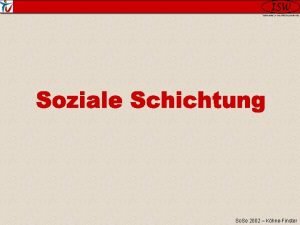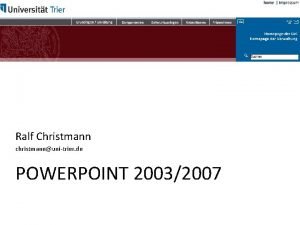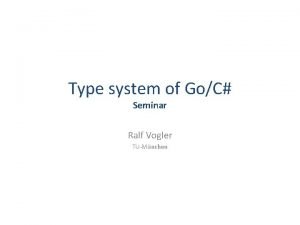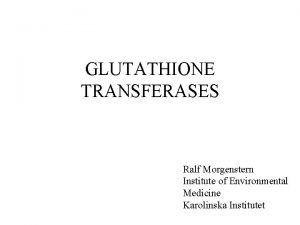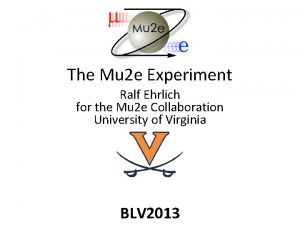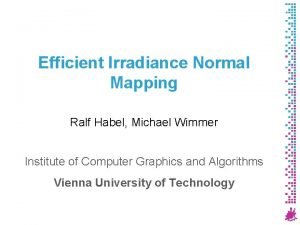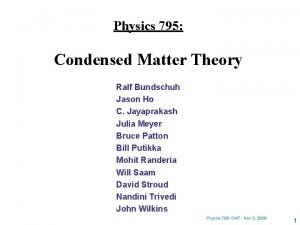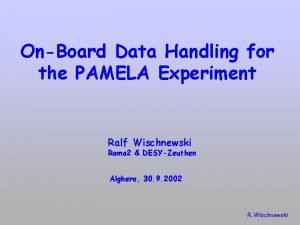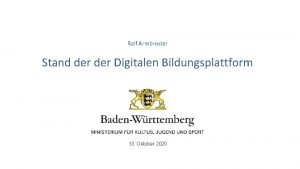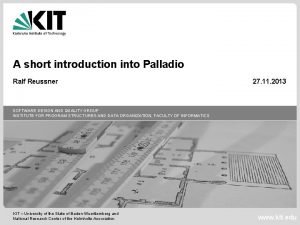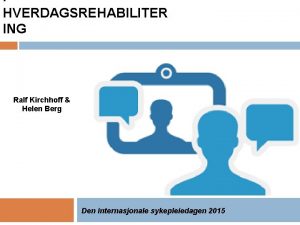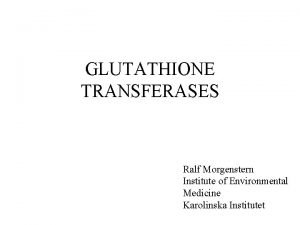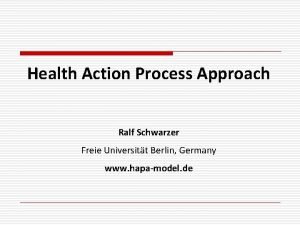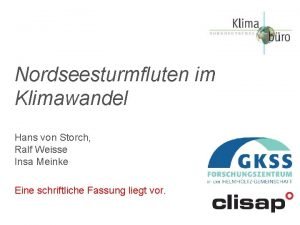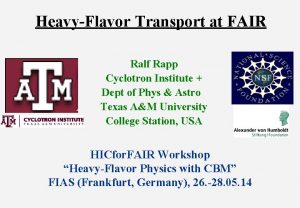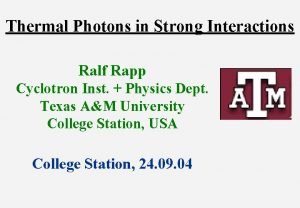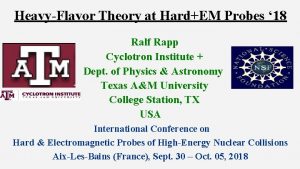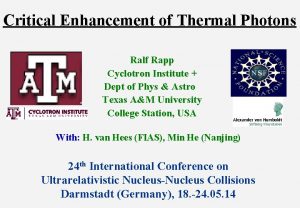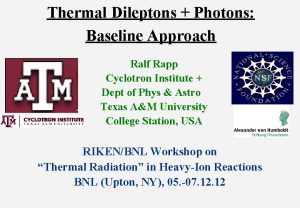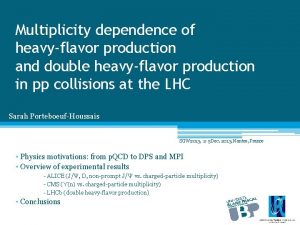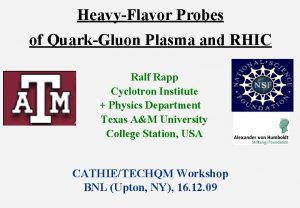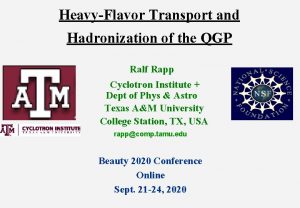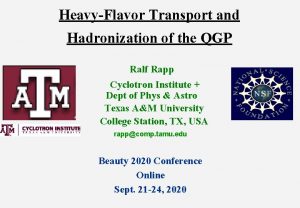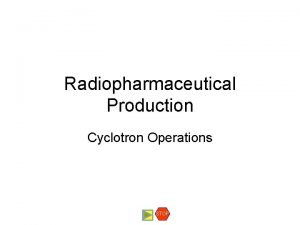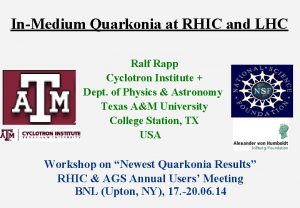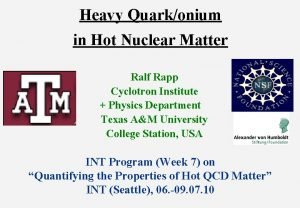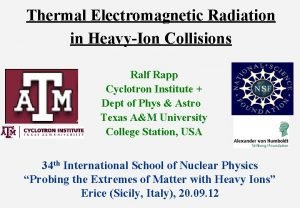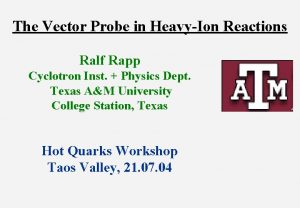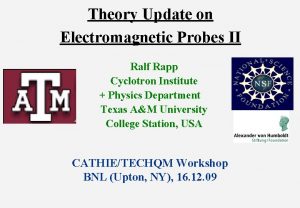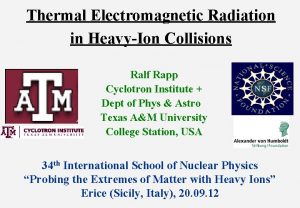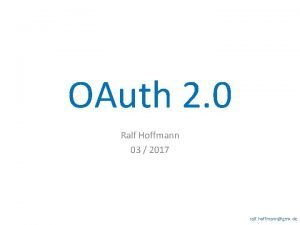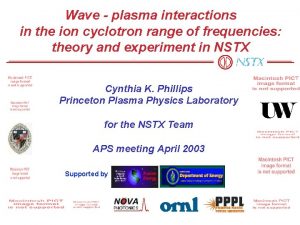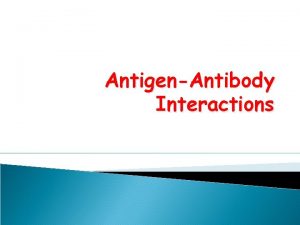HeavyFlavor Interactions in Medium Ralf Rapp Cyclotron Institute

![1. ) Introduction: A “Calibrated” QCD Force V [½ Ge. V] r [½ fm] 1. ) Introduction: A “Calibrated” QCD Force V [½ Ge. V] r [½ fm]](https://slidetodoc.com/presentation_image_h2/7d7cea7016099a92da2825d1e854117c/image-2.jpg)







![3. 1 Heavy-Light Interactions in QGP c-q- Thermal Relaxation Rate gc [1/fm] T-Matrix p 3. 1 Heavy-Light Interactions in QGP c-q- Thermal Relaxation Rate gc [1/fm] T-Matrix p](https://slidetodoc.com/presentation_image_h2/7d7cea7016099a92da2825d1e854117c/image-10.jpg)

![3. 3 Heavy-Flavor Transport in URHICs 0 | 0. 5 | t [fm/c] 5 3. 3 Heavy-Flavor Transport in URHICs 0 | 0. 5 | t [fm/c] 5](https://slidetodoc.com/presentation_image_h2/7d7cea7016099a92da2825d1e854117c/image-12.jpg)
![5. ) Charm Transport in Heavy-Ion Collisions [M. He et al ’ 14] • 5. ) Charm Transport in Heavy-Ion Collisions [M. He et al ’ 14] •](https://slidetodoc.com/presentation_image_h2/7d7cea7016099a92da2825d1e854117c/image-13.jpg)










![3. 3 D-Meson Transport in Hadronic Matter g. D [fm-1] • effective D-h scattering 3. 3 D-Meson Transport in Hadronic Matter g. D [fm-1] • effective D-h scattering](https://slidetodoc.com/presentation_image_h2/7d7cea7016099a92da2825d1e854117c/image-24.jpg)



![3. 5 J/y Predictions at LHC [Zhao+RR ‘ 11] • regeneration becomes dominant • 3. 5 J/y Predictions at LHC [Zhao+RR ‘ 11] • regeneration becomes dominant •](https://slidetodoc.com/presentation_image_h2/7d7cea7016099a92da2825d1e854117c/image-28.jpg)

![3. 2. 2 J/y at LHC: v 2 [He et al ’ 12] • 3. 2. 2 J/y at LHC: v 2 [He et al ’ 12] •](https://slidetodoc.com/presentation_image_h2/7d7cea7016099a92da2825d1e854117c/image-30.jpg)


- Slides: 32

Heavy-Flavor Interactions in Medium Ralf Rapp Cyclotron Institute + Dept. of Physics & Astronomy Texas A&M University College Station, TX USA 6 th Workshop of the APS Topical Group on Hadronic Physics Baltimore (MD), 08. -10. 04. 15
![1 Introduction A Calibrated QCD Force V ½ Ge V r ½ fm 1. ) Introduction: A “Calibrated” QCD Force V [½ Ge. V] r [½ fm]](https://slidetodoc.com/presentation_image_h2/7d7cea7016099a92da2825d1e854117c/image-2.jpg)
1. ) Introduction: A “Calibrated” QCD Force V [½ Ge. V] r [½ fm] • Vacuum charm-/bottomonium spectroscopy well described • Confinement ↔ linear part of potential • non-perturbative treatment in medium lattice QCD, potential / T-matrix approach, Ad. S/CFT, … [Kaczmarek et al ‘ 03]

1. 2 Objectives with Heavy Flavor in URHICs Determine modifications of QCD force in medium + infer consequences for the many-body system • exploit m. Q >> LQCD , Tc , T(RHIC, LHC) • Open heavy-flavor diffusion: “Brownian markers of QGP” - Scattering rates: widths, quasiparticles? (m. Q T) - Thermalization: delayed by m. Q/T → memory - Transport: diffusion coefficient Ds (2πT) ~ η/s • Quarkonia kinetics - Screening of confining (≥Tc? ) + Coulomb (≥ 2 Tc? ) force - ϒ states: sequential melting - ψ states: (sequential? ) regeneration

Outline 1. ) Introduction 2. ) Heavy-Quark Interactions in QGP 3. ) Open Heavy-Flavor Transport 4. ) Quarkonia: ψ Puzzle(s) 5. ) Conclusions

2. 1 Free + Internal Energy from Lattice QCD F 1(r, T) = U 1(r, T) – T Free Energy. S 1(r, T) Internal Energy • marked gradual “screening” • U = ‹Hint› • non-trivial many-body correlations • F, U, S thermodynamic quantities • Underlying ``bare” interaction?

2. 2 Thermodynamic T-Matrix in QGP • Lippmann-Schwinger equation In-Medium Q-Q T-Matrix: • thermal 2 -particle propagator: q, g • selfenergy: SQ = • rooted in vacuum spectroscopy; recovers p. QCD at large q 2 • in-medium potential V? [Cabrera+RR ’ 06, Riek+RR ‘ 10]

2. 2. 2 Free Energy from T-Matrix • Free Energy • Euclidean T-matrix in static limit • Spectral Function • Key ingredients: imaginary parts + their w dependence • heavy-quark selfenergies (from heavy-light T-matrix) [Beraudo et al ’ 08] [S. Liu+RR in progress] [S. Liu+RR ’ 15]

2. 2. 3. Free + Internal Energy from T-Matrix • field-theoretic potential ansatz: [Megias et al ’ 07] lattice data U V F 1. 2 Tc r [fm] 1. 5 Tc r [fm] 2 Tc r [fm] • remnant of long-range “confining” force in QGP

Outline 1. ) Introduction 2. ) Heavy-Quark Interactions in QGP 3. ) Open Heavy-Flavor Transport 4. ) Quarkonia: ψ Puzzle(s) 5. ) Conclusions
![3 1 HeavyLight Interactions in QGP cq Thermal Relaxation Rate gc 1fm TMatrix p 3. 1 Heavy-Light Interactions in QGP c-q- Thermal Relaxation Rate gc [1/fm] T-Matrix p](https://slidetodoc.com/presentation_image_h2/7d7cea7016099a92da2825d1e854117c/image-10.jpg)
3. 1 Heavy-Light Interactions in QGP c-q- Thermal Relaxation Rate gc [1/fm] T-Matrix p [Ge. V] • (pre-) resonances close to Tc • same interaction for transport + hadronization • • tc ≈ 3 fm/c close to Tc at low p • transition non-pert → pert. QCD

3. 2 Charm Diffusion Coefficient in Matter Ds =T/m. Qg. Q : Hadronic Matter vs. QGP vs. Lattice QCD [He et al ’ 11, Riek+RR ’ 10, Ding et al ‘ 11, Gavai et al ‘ 11] Ad. S/QCD • shallow minimum near Tc • Quark-Hadron continuity? [Gubser ‘ 07]
![3 3 HeavyFlavor Transport in URHICs 0 0 5 t fmc 5 3. 3 Heavy-Flavor Transport in URHICs 0 | 0. 5 | t [fm/c] 5](https://slidetodoc.com/presentation_image_h2/7d7cea7016099a92da2825d1e854117c/image-12.jpg)
3. 3 Heavy-Flavor Transport in URHICs 0 | 0. 5 | t [fm/c] 5 | D c • initial cond. (shadowing, • c-quark diffusion Cronin), in QGP liquid pre-equil. fields 10 | • c-quark hadronization • D-meson diffusion in hadron liquid • no “discontinuities” in interaction diffusion toward Tpc and hadronization same interaction (confining!)
![5 Charm Transport in HeavyIon Collisions M He et al 14 5. ) Charm Transport in Heavy-Ion Collisions [M. He et al ’ 14] •](https://slidetodoc.com/presentation_image_h2/7d7cea7016099a92da2825d1e854117c/image-13.jpg)
5. ) Charm Transport in Heavy-Ion Collisions [M. He et al ’ 14] • RAA “bump” from radial flow • Ds meson (cs) enhanced from coalescence with strange quarks • Coalescence + hadronic diffusion increase v 2 • similar features at RHIC

Outline 1. ) Introduction 2. ) Heavy-Quark Interactions in QGP 3. ) Open Heavy-Flavor Transport 4. ) Quarkonia: ψ Puzzle(s) 5. ) Conclusions

4. ) Quarkonium Transport in Heavy-Ion Collisions • Inelastic Reactions: [PBM+Stachel ’ 00, Thews et al ’ 01, Grandchamp+RR ‘ 01, Gorenstein et al ’ 02, Ko et al ’ 02, Andronic et al ‘ 03, Zhuang et al ’ 05, Ferreiro et al ‘ 11, …] → c + c- + X detailed balance: J/y + g ← • Rate Equation: D - D J/y c- c J/y • Transport coefficients - chemical relaxation rate Gy - equililbrium limit Nyeq(ey. B, mc* , tceq) • Phenomenology: - J/y, cc, y’+c, b initial distributions [pp, p. A] - medium evolution [AA: hydro, . . . ] Observables

4. 2 J/y Predictions at LHC • regeneration becomes dominant • uncertainties in scc+ shadowing • maximum at low pt corroborates regeneration [Zhao+RR ‘ 11]

4. 3. 1 Time Evolution of Charmonia in the Fireball Time Evolution Momentum Spectra • smaller binding → smaller Tdiss → y forms later than J/ψ ! • stronger fireball expansion for ψ → harder pt spectra (slope parameter Teff ~ T + m b┴ 2 ) [X. Du+RR ‘ 15]

4. 3. 2 Sequential Recombination + CMS Data ψ’ / J/ψ RAA Double Ratio • ψ blast wave fills pt = 3 -6 Ge. V region, primordial for pt > 6 Ge. V • helps explain CMS double-ratio “puzzle” [X. Du+RR ‘ 15]

5. ) Conclusions • Extract heavy-quark potential in QGP from lat-QCD free energy: - Large imaginary parts - Remnants of confinement generate strong coupling • “Critical” consequences for heavy-flavor diffusion: Continuity + minimum of transport coefficient through Tpc • Diffusion + hadronization from same interaction • Sequential recombination of charmonia? !

2. 2. 4 Brueckner Theory of Heavy Flavor in QGP Input lattice-QCD free energy 2 -body potential Quark selfenergy Process Q→Q 0 -modes - QQ T-matrix Qq T-matrix Output Test quark-no. susceptibility spectral fcts. / eucl. correlat. lattice data - evolution QQ (rate equation) exp. data Q spectra + v 2 (Langevin)

4. 2 Charmonia in d+Au Fireball • construct fireball + evolve rate equat. → y suppression from hot medium • similar in spirit to comover approach [Ferreiro ‘ 14] • formation time effects? ! [X. Du+RR, in prep] [Y. Liu, Ko et al ‘ 14]

4. ) Charmonium: y (3686) • easily dissociated in hadronic matter: p, r, . . . + y →DD, y → Dmed [Grandchamp +RR ‘ 02] [PBM+Stachel ‘ 00] • hadronic y dissociation at SPS important ingredient for transport models [Sorge et al ‘ 97, …]

3. 6 (1 S) and (2 S) at LHC Weak Binding Strong Binding (1 S) → (2 S) → [Grandchamp et al ’ 06, Emerick et al ‘ 11] • sensitive to color-screening + early evolution times • clear preference for strong binding (U potential) • similar results by [Strickland ‘ 12] • possible problem in rapidity dependence
![3 3 DMeson Transport in Hadronic Matter g D fm1 effective Dh scattering 3. 3 D-Meson Transport in Hadronic Matter g. D [fm-1] • effective D-h scattering](https://slidetodoc.com/presentation_image_h2/7d7cea7016099a92da2825d1e854117c/image-24.jpg)
3. 3 D-Meson Transport in Hadronic Matter g. D [fm-1] • effective D-h scattering amplitudes [He, Fries+RR ’ 11] • consistent with: - unitarized HQET (pion gas) [Cabrera et al ‘ 11] - recent works in HRG using similar methods [Tolos+Torres-Ricon ’ 13, Ozvenchuk et al ‘ 14] g. D [fm-1] • hadron gas at ~Tc: t. D ≈ 10 fm/c

3. 1 Thermal Charmonium Properties (a) Equilibrium Y number: • gc from fixed cc- number: • interplay of mc* and • constrain spectral shape by lattice-QCD correlators (b) Inelastic Y Width e y. B mc * q q • controlled by as (parameter) Gy

3. 3 Inclusive J/y at SPS + RHIC Strong Binding (U) Weak Binding (F) [Zhao+RR ‘ 10] • Fix two main parameters: as~0. 3, charm relax. tceq = 4(2) fm/c for U(F) vs. ~5(10) from T-matrix

3. 4 J/y Excitation Function: BES at RHIC PHENIX (forward y) STAR (central y) • suppression pattern varies little (expected from transport) [Grandchamp +RR ’ 02] • quantitative pp + p. A baseline critical to extract systematics
![3 5 Jy Predictions at LHC ZhaoRR 11 regeneration becomes dominant 3. 5 J/y Predictions at LHC [Zhao+RR ‘ 11] • regeneration becomes dominant •](https://slidetodoc.com/presentation_image_h2/7d7cea7016099a92da2825d1e854117c/image-28.jpg)
3. 5 J/y Predictions at LHC [Zhao+RR ‘ 11] • regeneration becomes dominant • uncertainties in scc+shadowing • low p. T maximum confirms regeneration • too much high-p. T suppression?

3. 7 Summary of Phenomenology • Quarkonium discoveries in URHICs: - increase of J/y RAA SPS, RHIC → LHC - low-p. T enhancement - sizable v 2 - increasing suppression of ’ (e. B ’ ~ e. BJ/y ) • Fair predictive power of theoretical modeling - based on description of SPS+RHIC with 2 main parameters • Implications - T 0 SPS (~230) < Tdiss(J/y, ’) < T 0 RHIC (~350) < T 0 LHC(~550) ≤ Tdiss( ) - confining force screened at RHIC+LHC - marked recombination of diffusing charm quarks at LHC
![3 2 2 Jy at LHC v 2 He et al 12 3. 2. 2 J/y at LHC: v 2 [He et al ’ 12] •](https://slidetodoc.com/presentation_image_h2/7d7cea7016099a92da2825d1e854117c/image-30.jpg)
3. 2. 2 J/y at LHC: v 2 [He et al ’ 12] • further increase at mid-y

3. 1. 2 J/y p. T Spectra + Elliptic Flow at RHIC (strong binding) • shallow minimum at low p. T • high p. T: formation time, b feeddown, Cronin • small v 2 limits regeneration, but does not exclude it

3. 2. 2 D-Meson Thermalization at LHC • to be determined…
 Ralf lore
Ralf lore Geoglam rapp
Geoglam rapp Krachtenmodel van rapp
Krachtenmodel van rapp Rapp method
Rapp method Rapp method
Rapp method Medium medium 35m newton
Medium medium 35m newton Hot and cold media examples
Hot and cold media examples Cyclotron diagram
Cyclotron diagram Uc davis cyclotron
Uc davis cyclotron Antaya science and technology
Antaya science and technology Formula for cyclotron
Formula for cyclotron Baby cyclotron
Baby cyclotron Cyclotron
Cyclotron Cyclotron
Cyclotron Cyclotron and synchrotron radiation
Cyclotron and synchrotron radiation Innolab smart mobility
Innolab smart mobility Ralf behnke
Ralf behnke Städtereisen ito
Städtereisen ito Ralf habel
Ralf habel Ralf dahrendorf hausmodell
Ralf dahrendorf hausmodell Entwurfsvorlagen powerpoint
Entwurfsvorlagen powerpoint Golang duck typing
Golang duck typing Ralf morgenstern
Ralf morgenstern Ralf ehrlich
Ralf ehrlich Ralf habel
Ralf habel Ralf bundschuh
Ralf bundschuh Pamela ralf
Pamela ralf Ralf armbruster
Ralf armbruster Ralf reussner
Ralf reussner Dr. ralf kirchhoff
Dr. ralf kirchhoff Ralf morgenstern
Ralf morgenstern Health action process approach
Health action process approach Ralf weiße
Ralf weiße
